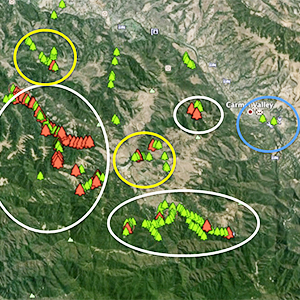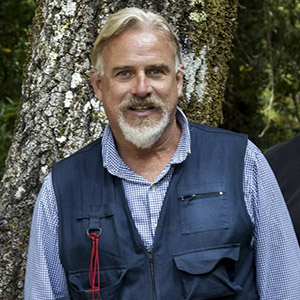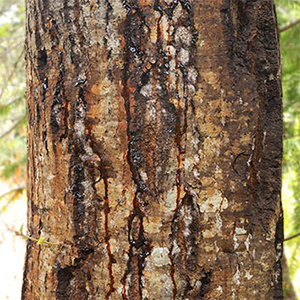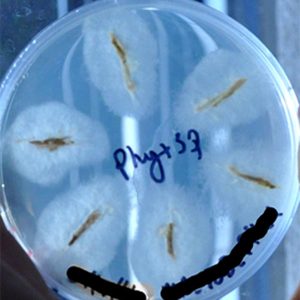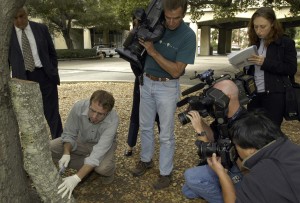There is no research or other observational evidence to indicate that glyphosate application increases Phytophthora ramorum infection. In mixed-evergreen and redwood forests some land managers use glyphosate to control invasive weeds, such as French broom, poison oak, and other problematic weeds. In coastal CA, these forest types contain coast live oak, California bay laurel, tanoak, and other plants susceptible to P. ramorum, but the disease is not known to spread or intensify due to glyphosate treatment.
Precautions. Always follow pesticide label instructions and consider non-pesticide alternatives to control pests. Pesticides can be injurious to humans, domestic animals, desirable plants, fish, and other wildlife if they are not handled or applied properly. Use all pesticides selectively and carefully. Follow recommended practices for the disposal of surplus pesticides and pesticide containers.
Oak testing is routinely done by arborists. It is a rather involved and tedious process that requires a fair amount of finesse and know how as it entails wounding the tree by shaving off the outer layer of bark to collect infected tissue. If you decide to have your oaks tested for SOD, consider going to the Trained Professionals List for arborists that have recently attended an official SOD seminar (Not intended to be a list of recommended professionals, this list does serve as an additional filter when trying to identify arborists that are up-to-date on the latest science-based SOD information.).
Alternatively, a less invasive method of determining the presence or absence of SOD on your property is to sample symptomatic bay leaves (See Hosts and Symptoms for SOD symptoms.). Keep in mind that any infested bay in the general vicinity (typically within 200 ft of an infected oak) may be the inoculum source for infection of your coast live oak. If bay sampling is your preferred method for pathogen detection, you can call your local UC Cooperative Extension office to find out if the California Department of Food and Agriculture is processing leaves from your county and, if so, what the protocol is for sample submissions. In lieu of submitting samples through your county, you can go to www.sodblitz.org to find out when a SOD Blitz will be held in your region (Dates for each year are posted by January 30th. Blitzes typically occur from March to June). Attending a blitz will afford you the opportunity to learn more about SOD, including the latest disease control strategies, during a 1-hour training session. At the end of the session you will be given all sampling materials and instructions for submissions. Blitz participants are free to submit as many leaves as necessary, meaning that you can send in all suspicious leaves from your property as well as from the neighborhood or nearby local parks. All leaves are processed at UC Berkeley and all sampling results are published in a database available at www.sodmap.org or through the free App SODmap mobile.
Phytophthora ramorum was not discovered as the causal agent of sudden oak death until 2000-2001. Prior to then, it was not understood to be a nursery issue; therefore, there was no concern about spread from nurseries into the wildlands. Since then, DNA analysis has confirmed that the pathogen was unknowingly introduced to both California and southern Oregon via infected nursery stock from multiple nurseries. Prior to 2000 and our knowledge of the pathogen, it appears P. ramorum was moving around via the sale and trade of infected ornamental plants and possibly through movement of cuttings or rootstock for production. While we do not know where the pathogen originates from or how ornamental plant nurseries originally were introduced to it, we believe the nursery to wildland introduction in California began around 1987 in Marin and Santa Cruz Counties.
Although there may be few insects flying in the winter, the wet winter season (actually fall through spring) is a prime time for production of fruiting bodies by many wood decay fungi. The combination of fresh pruning wounds (especially large wounds), high spore densities of wood decay fungi, and moist conditions (favoring spore germination) can favor new infections by these fungi. From the standpoint of reducing risk of infection by wood decay fungi, pruning in late spring or early summer is probably preferable.
In general, pruning live branches from mature oaks should be kept to a minimum. However, if it is necessary to prune coast live oak branches, as long as they are less than 4″ in diameter, the presence of SOD is not a concern. Though, it is important to prune the oak correctly.
• Make sure you prune right where the tapering of the branch ends from the main stem or even slightly closer to the stem (1/2 in. from the end of the tapering towards the stem).
• Make sure the cut is clean and allows for water to drip without accumulating.
Both bay laurels and tanoaks can spread SOD while most oaks are not infectious. Therefore, bay removal is typically aimed at protecting oaks. In the absence of bays, you may actually be able to facilitate survival of asymptomatic tanoaks, but only if their density is low (about 20 per acre). A possible plan of action may thus be to eliminate all medium-sized bay trees (up to 20 inch DBH) that are not in a riparian setting and to eliminate all infected tanoaks. You may then decide to leave a few well-spaced tanoaks (50 feet minimum from one another), ensuring none of them are within 30 feet of an oak.
Once down, spores from bay foliage will not travel nearly as far as they do in the canopy. The concern on the ground is that infested leaves, while still fresh, could have spores picked up during a wet event from soil splash onto the trunk of the tree. So, spread bay foliage in a thin layer in a sunny area that will promote drying. Be sure to not have foliage near the base of oak or tanoak trunks where soil splash/infection could occur.
There are currently two options for injections:
- Chemjet® injectors (coil activated) – volume to be injected = 20 ml; 10% of current label dose; pressure 20 PSI (pressure of injector is already set)
- Arborjet® injectors – volume to be injected = 40 ml; 5% of current label dose; pressure set at 35 PSI
Injections should be done every 2 years. Every year you inject, stagger injection points 2 inches up and 2 inches sideways.
• As a rule of thumb, use one injection every 6 inches, with all injections at the same height.
• Start injections the first year as low as possible on trunk.
• Avoid injecting under branch stubs or punks.
• Injections should take 1-10 minutes to be absorbed. If they are absorbed in less than 1 minute, the material was not absorbed by vessels. If it takes longer than 10 minutes to be absorbed, the timing was not good for the treatment.
• Good days/timing for injections are warm and breezy days between 10 am and 3 pm.
• Leave injection holes unplugged.
Does the sudden oak death pathogen sporulate on madrone like it does on California bay laurel? Sudden oak death can kill small madrones and cause significant dieback of larger madrones. While Phytophthora ramorum (the pathogen that causes sudden oak death) does sporulate on madrone, making in an infectious host, it is not a very effective at transmtting the pathogen as infected leaves whither rapidly, eliminating pathogen viability.
As a general rule, avoid planting under the canopy of oak trees. It is recommended that you remove non-native plants from under oaks but avoid disturbing the soil or drainage patterns in the process. If you need to plant something, choose species that require similar soil types and watering. Avoid azaleas and rhododendrons as they typically require more water than is appropriate for oaks and may transmit diseases such as Sudden Oak Death.

